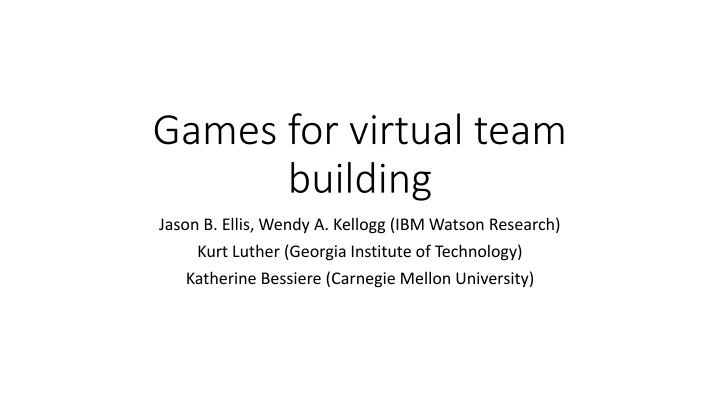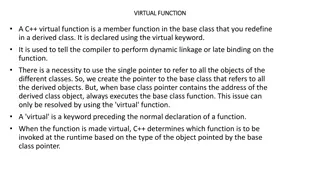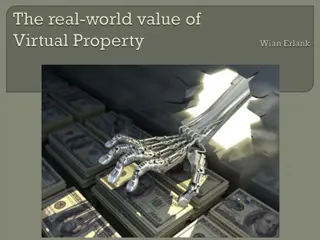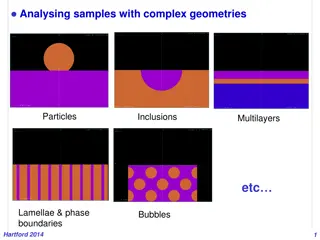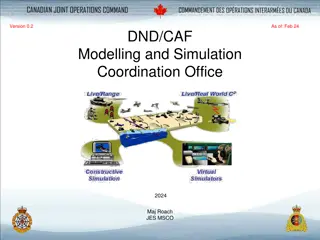Enhancing Virtual Team Building Through Games & Simulation
Distributed teams face communication challenges, affecting trust and cohesion. This research explores leveraging virtual worlds and games to address these issues, focusing on social identity, team building activities, and enhancing social and emotional communication. Emphasizing fun and engagement, alongside simulated face-to-face meetings in 3D virtual worlds, can lead to improved team dynamics and productivity.
Download Presentation

Please find below an Image/Link to download the presentation.
The content on the website is provided AS IS for your information and personal use only. It may not be sold, licensed, or shared on other websites without obtaining consent from the author.If you encounter any issues during the download, it is possible that the publisher has removed the file from their server.
You are allowed to download the files provided on this website for personal or commercial use, subject to the condition that they are used lawfully. All files are the property of their respective owners.
The content on the website is provided AS IS for your information and personal use only. It may not be sold, licensed, or shared on other websites without obtaining consent from the author.
E N D
Presentation Transcript
Games for virtual team building Jason B. Ellis, Wendy A. Kellogg (IBM Watson Research) Kurt Luther (Georgia Institute of Technology) Katherine Bessiere (Carnegie Mellon University)
Outline Motivation Challenges in Virtual Teams Approaches to address challenges Virtual World & Games Design Decisions for Games Conclusion
Motivation Distributed teams are commonplace in today s workplace, reflecting the spread of new forms of communication technology and the increasingly global nature of business. Face-to-Face meetings where members can most easily build trust are rare and often cost prohibitive. 3D virtual worlds and games may provide an alternate means for encouraging team development due to their affordances for facile communication, emotional engagement, and social interaction among participants. This research is inspired to bring the kind of distributed team building activities that happen naturally in online games to distributed teams in business.
Challenges to Virtual Teams Virtual teams have been shown to communicate less effectively than face-to-face teams, even as they communicate more frequently. A greater volume of communication in virtual teams may indicate a lack of clarity. Conversations in virtual teams have been shown to be more task-focused, to the exclusion of social interaction. A lack of social communication is also associated with lower trust and cohesion in the team, and with difficulties in establishing a shared knowledge base.
Approaches to address challenges Social Identity Group Membership is vital part of person s self-concept. Social identity depends on individual categorizing themselves as part of group, identifying with that group and compare their group with others. When a group is more salient to an individual, they will identify more strongly with group. Greater identification with a group leads to greater trust and cohesion, improved communication, improved cooperation, greater individual contribution of the group and increased group productivity. Team Building Team Building activities tend to emphasize following components : goal settings, interpersonal relations, problem solving and role clarification.
Social and Emotional Communication Virtual teams are more task focused which hampers their social communications. Increasing social communications between virtual team members leads to increase in social trust and emotional relationship. Emphasize on Fun and Engagement in team building activities increase the probability of social interaction Simulated Face to Face Meetings Successful strategy for virtual teams is to have face to face meetings in the earlier stages 3D virtual worlds where individuals create avatars and interact with others is the possibility in todays reality for face to face communication.
Virtual World & Games Need We saw Social & Economical challenges in Virtual teams and how Team Building activities and Face to Face meet can bring value to team Potential Match Online Games like World of Warcraft and Battlefield provide opportunities for players to achieve goals cooperatively. Discussion in this games break social and economical barriers. Avatars in the games simulate Face to Face meet. Author s Research Author s Designed three games with the aim to help distributed teams reflect on their work practice and develop deeper ties with their teammates at a distance.
Virtual Environment Author s choose Second Life as a 3D Multi-user virtual environment for Games Design & Development Second Life Each user presence is expressed bodily as Avatars It has user generate content like customized hairs, clothing, dance animations, fireworks, buildings, furniture etc. Private and Public chat features for Participants Offline messaging to increase social relationships.
Games Overview Each game included common elements : 1) Everyone in group must participate 2) Success is difficult if team fails to work together 3) Communication is critical to find solutions Iterative design approach was used starting with prototype, getting formative feedback, revising the game, building additional games
Game 1 : Crossing the Ravine Game Description: Team of Five tries to cross a ravine by building bridge. Each member has an object that when connected together forms a bridge to cross the ravine. Game Control: Each member sits on Chair Control object movement using chair Strategies: Each member should communicate to solve puzzle Scoring Criteria: Scoring is based on speed with which team solves puzzle
Game 2: Tower of Babble Game Description: It is a stacking game. The objective is to balance as many differently shaped blocks on top of one another until the stack of blocks (the tower) falls over. Game Control: Each member stack block in turn Move block and place on the tower Strategies: Stack ones block safely Go around tower and help others Scoring Criteria: Scoring is based on height and number of blocks placed before tower falls.
Game 3: Castle Builder Game Description: The objective of Castle Builder is to design and build a castle out of the pieces provided. Each castle is designed Designers and built by Builders. Builders are not allowed to directly view the design and must rely on information communicated by the Designers, and Designers are not allowed to manipulate the castle pieces during this game. Scoring Criteria: score for originality, correctness (to the design), and difficulty Designers Design Builders Building Castle
Game Process: The first phase of the game is design. Designers move to the design platform and develop a blueprint. At the same time, Builders are encouraged to take stock of the pieces they have available to them. Once the designers have finished, they teleport back to the building platform and use a heads up display of the castle design to tell the builders where to place the pieces. Strategies: The Builders rely on communication from the Designers to build the castle. The castle is finished when the castle matches the design, and team members then take on the opposite role and play again. A possible twist in the game allows the design of the castle to require more pieces than are available to the builders, which will necessitate a renegotiation of the design.
Design Decisions in Games Design Decision in games depends not only on the design of the games, but also the affordances and constraints of the world and the purpose for which the games were being built. Authors Detailed Design Decision on four levels The world containing the games To enhance the feeling of groupness, The games themselves level of player interaction with the games
Design Decisions: World, Group World Both Technical and Virtual Aspects of the world affect the game. Every User bring different set of experience with them about virtual design. A primary concern was to keep things simple for the users of the games in terms of avatars, controls to move objects, physical properties of surrounding Groupness Games are designed with the aim to foster identification with the group, in order to increase trust and cohesion. To reinforce commonalities between the members authors created some artificial commonalities and made the presence of other teams more prominent and visible. Each team that enters the world is given a T-shirt that is the same color (every team has a different color). Each team is also given a clubhouse (decorated in the same team color)
Design Decisions: Games Authors decided that games would be designed with focus on cooperation collaboration, and on communication for success, and allow team members to explore different roles. Games can play a role allowing players to step out of their work environment to engage in a fun activity that examines work practice more objectively Authors aimed to provide a lens through which players can reflect on their current work practice particularly in the area of cooperative work.
Cooperation: Cooperation is essential to the success of a group endeavor in which the members are dependent upon each other for success. A team that cooperates with each other as they work towards a common goal will perform better than one that does not Tower of Babble: Players began offering feedback to other teammates and heeding suggestions provided to them during their own turns. Crossing the ravine: Players are asked to cooperatively solve a puzzle. Castle Builder: Castle Builder requires cooperation between roles as well as individual team members. Designers must cooperate with builders by explaining them about the Design a they build. Communication: In order to achieve cooperation, and thus the best team outcomes, teams need to develop good communication strategies. Tower of Babble: Players communicated and helped other team members by going around tower giving constructive suggestion to place the block. Crossing the ravine: Players communicate to determine the correct solution to the puzzle, developing a plan of action and then players would execute the agreed-upon plan, stopping to renegotiate the solution each time a solution proved nonviable. Castle Builder: Designers communicated the plan to builders. Builders communicated designers back if current design required more pieces of blocks than they really have.
Roles: Role ambiguity is a problem that arises in virtual teams due to the difficulty in disseminating and interpreting information and forming a shared mental model. Crucial to virtual team success is the ability of a team to determine the abilities of team members, establish the roles they will play on the team, and coordinate these roles. Games were likely to be tested by IBM Software and hardware development employees and thus roles in the games were made based on this context. In real world there is always a conflict of interest between planning and implementation team, to be precise designers and developers. Similar disparity we saw in Castle builder game where when designers cam up with plan but due to lack of blocks builders demanded changes of plan. In Crossing the Ravine, all players have essentially the same charge. In Tower of babble and crossing the ravine we saw another important role emerging that of helpers.
Conclusion Crossing the Ravine, Tower of Babble, and Castle Builder were developed in sequence; each was more complex than the last According to authors observations games enable role formation, cooperation, and communication between team members. In addition, games elicit social behaviors from participants. Completion of games, especially when coupled with a high score, was often followed by spontaneous group celebrations such as dancing, drinking (virtual) champagne together, or animations such as cartwheels. The games discussed in the paper aimed to help distributed teams reflect on their work practice and develop deeper ties with their teammates at a distance. The intersection of social science principles, user-centered design, platform constraints, and happy accidents governed their design.
